7.5E:
( \newcommand{\kernel}{\mathrm{null}\,}\)
Exercise 7.5E.1
In the following exercises, evaluate the triple integrals ∭ over the solid E.
1.
f(x,y,z) = z, \quad B = \big\{(x,y,z)\, | \,x^2 + y^2 \leq 9, \quad x \leq 0, \quad y \leq 0, \quad 0 \leq z \leq 1\big\}
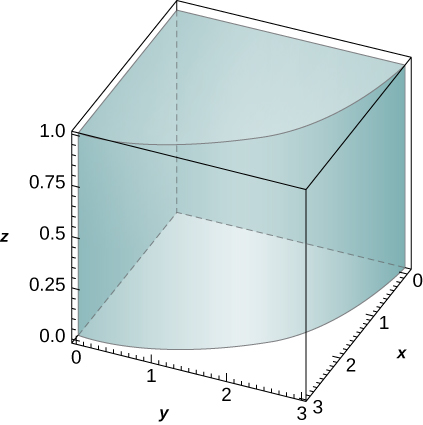
- Answer
- \frac{9\pi}{8}
2. f(x,y,z) = xz^2, \space B = \{(x,y,z) | x^2 + y^2 \leq 16, \space x \geq 0, \space y \leq 0, \space -1 \leq z \leq 1\}
3.
f(x,y,z) = xy, \space B = \big\{(x,y,z)\, | \,x^2 + y^2 \leq 1, \space x \geq 0, \space x \geq y, \space -1 \leq z \leq 1\big\}
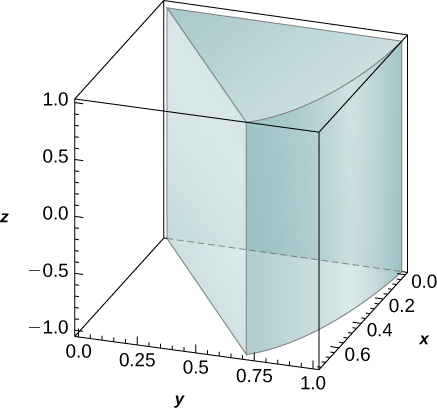
- Answer
- \frac{1}{8}
4. f(x,y,z) = x^2 + y^2, \space B = \{(x,y,z) | x^2 + y^2 \leq 4, \space x \geq 0, \space x \leq y, \space 0 \leq z \leq 3\}
5. f(x,y,z) = e^{\sqrt{x^2+y^2}}, \space B = \{(x,y,z) | 1 \leq x^2 + y^2 \leq 4, \space y \leq 0, \space x \leq y\sqrt{3}, \space 2 \leq z \leq 3 \}
- Answer
-
\frac{\pi e^2}{6}
6. f(x,y,z) = \sqrt{x^2 + y^2}, \space B = \{(x,y,z) | 1 \leq x^2 + y^2 \leq 9, \space y \leq 0, \space 0 \leq z \leq 1\}
Exercise \PageIndex{2}
7.
a. Let B be a cylindrical shell with inner radius a outer radius b, and height c where 0 < a < b and c>0. Assume that a function F defined on B can be expressed in cylindrical coordinates as F(x,y,z) = f(r) + h(z), where f and h are differentiable functions. If \int_a^b \bar{f} (r) dr = 0 and \bar{h}(0) = 0, where \bar{f} and \bar{h} are antiderivatives of f and h, respectively, show that
\iiint_B F(x,y,z) dV = 2\pi c (b\bar{f} (b) - a \bar{f}(a)) + \pi(b^2 - a^2) \bar{h} (c).
b. Use the previous result to show that
\iiint_B \left(z + sin \sqrt{x^2 + y^2}\right) dx \space dy \space dz = 6 \pi^2 ( \pi - 2),
where B is a cylindrical shell with inner radius \pi outer radius 2\pi, and height 2.
8.
a. Let B be a cylindrical shell with inner radius a outer radius b and height c where 0 < a < b and c > 0. Assume that a function F defined on B can be expressed in cylindrical coordinates as F(x,y,z) = f(r) g(\theta) f(z)\), where f, \space g, and h are differentiable functions. If \int_a^b \tilde{f} (r) dr = 0, where \tilde{f} is an antiderivative of f, show that
\iiint_B F (x,y,z)dV = [b\tilde{f}(b) - a\tilde{f}(a)] [\tilde{g}(2\pi) - \tilde{g}(0)] [\tilde{h}(c) - \tilde{h}(0)],
where \tilde{g} and \tilde{h} are antiderivatives of g and h, respectively.
b. Use the previous result to show that \iiint_B z \space sin \sqrt{x^2 + y^2} dx \space dy \space dz = - 12 \pi^2, where B is a cylindrical shell with inner radius \pi outer radius 2\pi, and height 2.
Exercise \PageIndex{3}
In the following exercises, the boundaries of the solid E are given in cylindrical coordinates.
a. Express the region E in cylindrical coordinates.
b. Convert the integral \iiint_E f(x,y,z) dV to cylindrical coordinates.
9. E is bounded by the right circular cylinder r = 4 \space sin \space \theta, the r\theta-plane, and the sphere r^2 + z^2 = 16.
- Answer
-
a. E = \{(r,\theta,z) | 0 \leq \theta \leq \pi, \space 0 \leq r \leq 4 \space sin \space \theta, \space 0 \leq z \leq \sqrt{16 - r^2}\}
b. \int_0^{\pi} \int_0^{4 \space sin \space \theta} \int_0^{\sqrt{16-r^2}} f(r,\theta, z) r \space dz \space dr \space d\theta
10. E is bounded by the right circular cylinder r = cos \space \theta, the r\theta-plane, and the sphere r^2 + z^2 = 9.
11. E is located in the first octant and is bounded by the circular paraboloid z = 9 - 3r^2, the cylinder r = \sqrt{r}, and the plane r(cos \space \theta + sin \space \theta) = 20 - z.
- Answer
-
a. \(E = \{(r,\theta,z) |0 \leq \theta \leq \frac{\pi}{2}, \space 0 \leq r \leq \sqrt{3}, \space 9 - r^2 \leq z \leq 10 - r(cos \space \theta + sin \space \theta)\};
b. \int_0^{\pi/2} \int_0^{\sqrt{3}} \int_{9-r^2}^{10-r(cos \space \theta + sin \space \theta)} f(r,\theta,z) r \space dz \space dr \space d\theta
12. E is located in the first octant outside the circular paraboloid z = 10 - 2r^2 and inside the cylinder r = \sqrt{5} and is bounded also by the planes z = 20 and \theta = \frac{\pi}{4}.
Exercise \PageIndex{4}
The following exercises give the function f and region E.
a. Express the region E and the function f in cylindrical coordinates.
b. Convert the integral \iiint_B f(x,y,z) dV into cylindrical coordinates and evaluate it.
13. f(x,y,z) = \frac{1}{x+3}, E = \{(x,y,z) | 0 \leq x^2 + y^2 \leq 9, \space x \geq 0, \space y \geq 0, \space 0 \leq z \leq x + 3\}
- Answer
-
a. E = \{(r,\theta,z) | 0 \leq r \leq 3, \space 0 \leq \theta \leq \frac{\pi}{2}, \space 0 \leq z \leq r \space cos \space \theta + 3\},f(r,\theta,z) = \frac{1}{r \space cos \space \theta + 3};
b. \int_0^3 \int_0^{\pi/2} \int_0^{r \space cos \space \theta+3} \frac{r}{r \space cos \space \theta + 3} dz \space d\theta \space dr = \frac{9\pi}{4}
14. f(x,y,z) = x^2 + y^2, \space E = \{(x,y,z) |0 \leq x^2 + y^2 \leq 4, \space y \geq 0, \space 0 \leq z \leq 3 - x
15. f(x,y,z) = x, \space E = \{(x,y,z) | 1 \leq y^2 + z^2 \leq 9, \space 0 \leq x \leq 1 - y^2 - z^2\}
- Answer
-
a. y = r \space cos \space \theta, \space z = r \space sin \space \theta, \space x = z,\space E = \{(r,\theta,z) | 1 \leq r \leq 3, \space 0 \leq \theta \leq 2\pi, \space 0 \leq z \leq 1 - r^2\}, \space f(r,\theta,z) = z;
b. \int_1^3 \int_0^{2\pi} \int_0^{1-r^2} z r \space dz \space d\theta \space dr = \frac{256 \pi}{3}
16. f(x,y,z) = y, \space E = \{(x,y,z) | 1 \leq x^2 + z^2 \leq 9, \space 0 \leq y \leq 1 - x^2 - z^2 \}
Exercise \PageIndex{5}
In the following exercises, find the volume of the solid E whose boundaries are given in rectangular coordinates.
17. E is above the xy-plane, inside the cylinder x^2 + y^2 = 1, and below the plane z = 1.
- Answer
-
\pi
18. E is below the plane z = 1 and inside the paraboloid z = x^2 + y^2.
19. E is bounded by the circular cone z = \sqrt{x^2 + y^2} and z = 1.
- Answer
-
\frac{\pi}{3}
20. E is located above the xy-plane, below z = 1, outside the one-sheeted hyperboloid x^2 + y^2 - z^2 = 1, and inside the cylinder x^2 + y^2 = 2.
21. E is located inside the cylinder x^2 + y^2 = 1 and between the circular paraboloids z = 1 - x^2 - y^2 and z = x^2 + y^2.
- Answer
-
\dfrac{\pi}{4}
22. E is located inside the sphere x^2 + y^2 + z^2 = 1, above the xy-plane, and inside the circular cone z = \sqrt{x^2 + y^2}.
23. E is located outside the circular cone x^2 + y^2 = (z - 1)^2 and between the planes z = 0 and z = 2.
- Answer
-
\frac{2\pi}{3}
24. E is located outside the circular cone z = 1 - \sqrt{x^2 + y^2}, above the xy-plane, below the circular paraboloid, and between the planes z = 0 and z = 2.
Exercise \PageIndex{6}
25. [T] Use a computer algebra system (CAS) to graph the solid whose volume is given by the iterated integral in cylindrical coordinates \displaystyle \int_{-\pi/2}^{\pi/2} \int_0^1 \int_{r^2}^r r \, dz \, dr \, d\theta. Find the volume V of the solid. Round your answer to four decimal places.
- Answer
-
V = \frac{pi}{12} \approx 0.2618
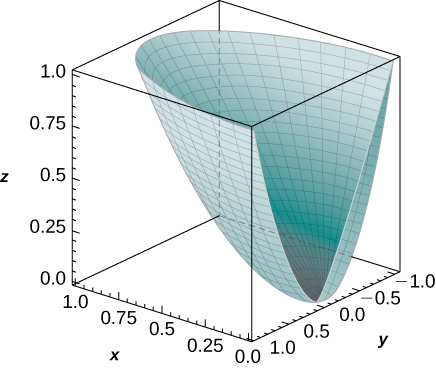
26. [T] Use a CAS to graph the solid whose volume is given by the iterated integral in cylindrical coordinates \displaystyle \int_0^{\pi/2} \int_0^1 \int_{r^4}^r r \, dz \, dr \, d\theta. Find the volume E of the solid. Round your answer to four decimal places.
Exercise \PageIndex{7}
27. Convert the integral \int_0^1 \int_{-\sqrt{1-z^2}}^{\sqrt{1-y^2}} \int_{x^2+y^2}^{\sqrt{x^2+y^2}} xz \space dz \space dx \space dy into an integral in cylindrical coordinates.
- Answer
-
\[\int_0^1 \int_0^{\pi} \int_{r^2}^r zr^2 \space cos \space \theta \space dz \space d\theta \space dr\
28. Convert the integral \int_0^2 \int_0^x \int_0^1 (xy + z) dz \space dx \space dy into an integral in cylindrical coordinates.
Exercise \PageIndex{8}
In the following exercises, evaluate the triple integral \iiint_B f(x,y,z)dV over the solid B.
29. f(x,y,z) = 1, \space B = \{(x,y,z) | x^2 + y^2 + z^2 \leq 90, \space z \geq 0\}
30. f(x,y,z) = 1, \space B = \big\{(x,y,z)\, | \,x^2 + y^2 + z^2 \leq 90, \space z \geq 0\big\}
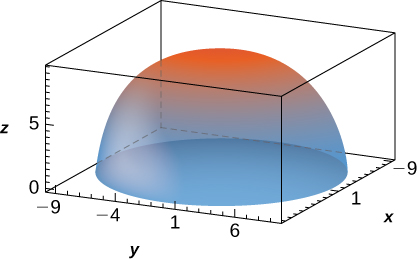
[Hide Solution]
- Answer
- 180 \pi \sqrt{10}
31. f(x,y,z) = 1 - \sqrt{x^2 + y^2 + z^2}, \space B = \big\{(x,y,z)\, | \,x^2 + y^2 + z^2 \leq 9, \space y \geq 0, \space z \geq 0\big\}
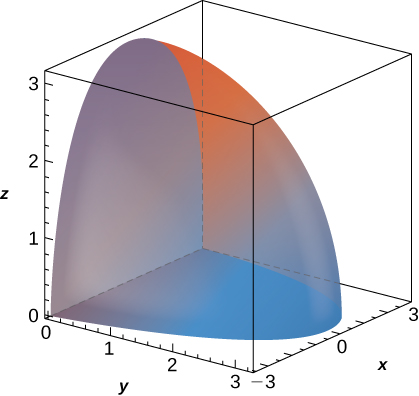
32. f(x,y,z) = \sqrt{x^2 + y^2}, \space B is bounded above by the half-sphere x^2 + y^2 + z^2 = 9 with z \geq 0 and below by the cone z^2 = x^2 + y^2.
- Answer
- \frac{81\pi(\pi - 2)}{16}
33. f(x,y,z) = \sqrt{x^2 + y^2}, \space B is bounded above by the half-sphere x^2 + y^2 + z^2 = 16 with z \geq 0 and below by the cone 2z^2 = x^2 + y^2.
Exercise \PageIndex{9}
34. Show that if F ( \rho,\theta,\varphi) = f(\rho)g(\theta)h(\varphi) is a continuous function on the spherical box B = \big\{(\rho,\theta,\varphi)\, | \,a \leq \rho \leq b, \space \alpha \leq \theta \leq \beta, \space \gamma \leq \varphi \leq \psi\big\}, then \displaystyle\iiint_B F \space dV = \left(\int_a^b \rho^2 f(\rho) \space dr \right) \left( \int_{\alpha}^{\beta} g (\theta) \space d\theta \right)\left( \int_{\gamma}^{\psi} h (\varphi) \space \sin \varphi \space d\varphi \right).
35. A function F is said to have spherical symmetry if it depends on the distance to the origin only, that is, it can be expressed in spherical coordinates as F(x,y,z) = f(\rho), where \rho = \sqrt{x^2 + y^2 + z^2}. Show that \displaystyle\iiint_B F(x,y,z) \,dV = 2\pi \int_a^b \rho^2 f(\rho) \,d\rho, where B is the region between the upper concentric hemispheres of radii a and b centered at the origin, with 0 < a < b and F a spherical function defined on B.
Use the previous result to show that \displaystyle\iiint_B (x^2 + y^2 + z^2) \sqrt{x^2 + y^2 + z^2} dV = 21 \pi, where B = \big\{(x,y,z)\, | \,1 \leq x^2 + y^2 + z^2 \leq 2, \space z \geq 0\big\}.
36. Let B be the region between the upper concentric hemispheres of radii a and b centered at the origin and situated in the first octant, where 0 < a < b. Consider F a function defined on B whose form in spherical coordinates (\rho,\theta,\varphi) is F(x,y,z) = f(\rho)\cos \varphi. Show that if g(a) = g(b) = 0 and \displaystyle\int_a^b h (\rho) \, d\rho = 0, then \displaystyle\iiint_B F(x,y,z)\,dV = \frac{\pi^2}{4} [ah(a) - bh(b)], where g is an antiderivative of f and h is an antiderivative of g.
Use the previous result to show that \displaystyle \iiint_B = \frac{z \cos \sqrt{x^2 + y^2 + z^2}}{\sqrt{x^2 + y^2 + z^2}} \, dV = \frac{3\pi^2}{2}, where B is the region between the upper concentric hemispheres of radii \pi and 2\pi centered at the origin and situated in the first octant.
Exercise \PageIndex{10}
The following exercises give the function f and region E.
a. Express the region E and function f in spherical coordinates.
b. Convert the integral \iiint_B f(x,y,z)dV into cylindrical coordinates and evaluate it.
37. f(x,y,z) = z; \space E = \{(x,y,z) | 0 \leq x^2 + y^2 + z^2 \leq 1, \space z \geq 0\}
38. f(x,y,z) = x + y; \space E = \{(x,y,z) | 1 \leq x^2 + y^2 + z^2 \leq 2, \space z \geq 0, \space y \geq 0\}
- Answer
-
a. f(\rho,\theta, \varphi) = \rho \space sin \space \varphi \space (cos \space \theta + sin \space \theta), \space E = \{(\rho,\theta,\varphi) | 1 \leq \rho \leq 2, \space 0 \leq \theta \leq \pi, \space 0 \leq \varphi \leq \frac{\pi}{2}\};
b. \int_0^{\pi} \int_0^{\pi/2} \int_1^2 \rho^3 \space sin^2 \space \varphi (cos \space \theta + sin \space \theta) \space d\rho \space d\varphi \space d\theta = \frac{15\pi}{8}
39. f(x,y,z) = 2xy; \space E = \{(x,y,z) | \sqrt{x^2 + y^2} \leq z \leq \sqrt{1 - x^2 - y^2}, \space x \geq 0, \space y \geq 0\}
40. f(x,y,z) = z; \space E = \{(x,y,z) | x^2 + y^2 + z^2 - 2z\leq 0, \space \sqrt{x^2 + y^2} \leq z\}
- Answer
-
a. f(\rho,\theta,\varphi) = \rho \space cos \space \varphi; \space E = \{(\rho,\theta,\varphi) | 0 \leq \rho \leq 2 \space cos \space \varphi, \space 0 \leq \theta \leq 2 \pi, \space 0 \leq \varphi \leq \frac{\pi}{4}\};
b. \int_0^{2\pi} \int_0^{\pi/4} \int_0^{2 \space cos \space \varphi} \rho^3 sin \space \varphi \space cos \space \varphi \space d\rho \space d\varphi \space d\theta = \frac{7\pi}{6}
Exercise \PageIndex{11}
In the following exercises, find the volume of the solid E whose boundaries are given in rectangular coordinates.
41. E = \{ (x,y,z) | \sqrt{x^2 + y^2} \leq z \leq \sqrt{16 - x^2 - y^2}, \space x \geq 0, \space y \geq 0\}
42. E = \{ (x,y,z) | x^2 + y^2 + z^2 - 2z \leq 0, \space \sqrt{x^2 + y^2} \leq z\}
- Answer
-
\(\pi\
)
43. Use spherical coordinates to find the volume of the solid situated outside the sphere \rho = 1 and inside the sphere \rho = cos \space \varphi, with \varphi \in [0,\frac{\pi}{2}].
44. Use spherical coordinates to find the volume of the ball \rho \leq 3 that is situated between the cones \varphi = \frac{\pi}{4} and \varphi = \frac{\pi}{3}.
- Answer
-
9\pi (\sqrt{2} - 1)
45. Convert the integral\int_{-4}^4 \int_{-\sqrt{16-y^2}}^{\sqrt{16-y^2}} \int_{-\sqrt{16-x^2-y^2}}^{\sqrt{16-x^2-y^2}} (x^2 + y^2 + z^2) \, dz \, dx \, dy into an integral in spherical coordinates.
46. Convert the integral \displaystyle \int_0^4 \int_0^{\sqrt{16-x^2}} \int_{-\sqrt{16-x^2-y^2}}^{\sqrt{16-x^2-y^2}} (x^2 + y^2 + z^2)^2 \, dz \space dy \space dx into an integral in spherical coordinates.
- Answer
- \displaystyle\int_0^{\pi/2} \int_0^{\pi/2} \int_0^4 \rho^6 \sin \varphi \, d\rho \, d\phi \, d\theta
Exercise \PageIndex{14}
48. [T] Use a CAS to graph the solid whose volume is given by the iterated integral in spherical coordinates
\displaystyle \int_{\pi/2}^{\pi} \int_{5\pi}^{\pi/6} \int_0^2 \rho^2 \sin \varphi \space d\rho \space d\varphi \space d\theta.
Find the volume V of the solid. Round your answer to three decimal places.
- Answer
-
V = \frac{4\pi\sqrt{3}}{3} \approx 7.255
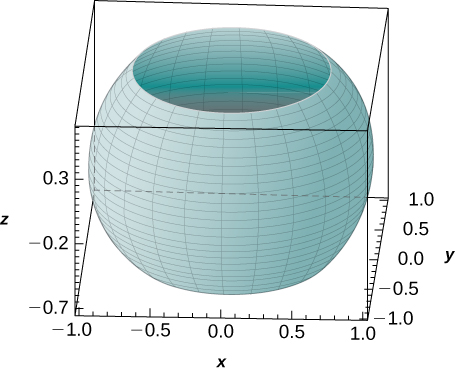
49. [T] Use a CAS to graph the solid whose volume is given by the iterated integral in spherical coordinates as
\displaystyle \int_0^{2\pi} \int_{3\pi/4}^{\pi/4} \int_0^1 \rho^2 \sin \varphi \space d\rho \space d\varphi \space d\theta.
Find the volume V of the solid. Round your answer to three decimal places.
50. [T] Use a CAS to evaluate the integral \displaystyle \iiint_E (x^2 + y^2) \, dV where E lies above the paraboloid
z = x^2 + y^2 and below the plane z = 3y.
- Answer
-
\frac{343\pi}{32}
51. [T]
a. Evaluate the integral \iiint_E e^{\sqrt{x^2+y^2+z^2}}dV, where E is bounded by spheres 4x^2 + 4y^2 + 4z^2 = 1 and
x^2 + y^2 + z^2 = 1.
b. Use a CAS to find an approximation of the previous integral. Round your answer to two decimal places.
Exercise \PageIndex{14}
52. Express the volume of the solid inside the sphere x^2 + y^2 + z^2 = 16 and outside the cylinder x^2 + y^2 = 4as triple integrals
in cylindrical coordinates and spherical coordinates, respectively.
- Answer
- \displaystyle \int_0^{2\pi}\int_2^4\int_{−\sqrt{16−r^2}}^{\sqrt{16−r^2}}r\,dz\,dr\,dθ and
- \displaystyle \int_{\pi/6}^{5\pi/6}\int_0^{2\pi}\int_{2\csc \phi}^{4}\rho^2\sin \rho \, d\rho \, d\theta \, d\phi
53. Express the volume of the solid inside the sphere x^2 + y^2 + z^2 = 16 and outside the cylinder x^2 + y^2 = 4 that is located in the first octant as triple integrals in cylindrical coordinates and spherical coordinates, respectively.
Contributors
Gilbert Strang (MIT) and Edwin “Jed” Herman (Harvey Mudd) with many contributing authors. This content by OpenStax is licensed with a CC-BY-SA-NC 4.0 license. Download for free at http://cnx.org.


